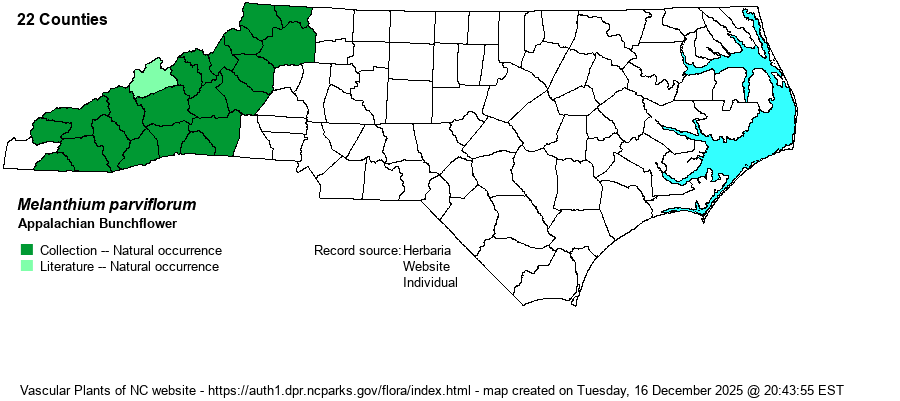| Author | (Michaux) S. Watson | |
| Distribution | Throughout the Mountains and upper Piedmont. Apparently does not occur downstate in Piedmont outlier ranges.
This is a Southern Appalachian endemic, being found from northern VA and eastern WV south to northern GA and northeastern AL. | |
| Abundance | Fairly common to locally common in most of the Mountains, most frequent in the middle or higher elevations. Apparently rare in the Piedmont. | |
| Habitat | This lily is not usually found in overly rich or moist forest sites, but favors dry-mesic to mesic forest slopes, often in oak forests. It can be found in Northern Hardwood Forests and Acidic Cove Forests, but is not normally to be looked for in Rich Cove Forests. | |
| Phenology | Blooms from July into early September, and fruits from August to October. | |
| Identification | This lily has broader basal leaves than most others found on forested mountain slopes. Each of the elliptical basal leaves is 6-8 inches long and about 1/2 as wide, up to 3-4 inches wide; the plant can be confused with an orchid or one of the two Clintonia species when only in leaf. However, it is one of the few NC plants with strongly green flowers. The fairly tall panicle grows up to 2-3 feet high, with a few dozen small olive-green flowers, each barely 1/2-inch across. The flowers of Veratrum viride are also olive-green, but this species has leaves coming off a vertical stalk, as opposed to just being in a basal clump; its flowers are also larger. In actuality, it is very similar to M. woodii, but this species has maroon-purple flowers as opposed to green; it is extremely rare in the state (one known site in Polk County). You should be able to see Appalachian Bunchflower in a few walks at middle or higher elevations in hardwood forests, though such walks might be too early in the season to catch it in bloom. The numerous small green flowers should be obvious in late summer. | |
| Taxonomic Comments | This species was long placed in the genus Veratrum, such as in RAB (1968). That genus has green or purple flowers, as opposed to white in the original Melanthium; however, several of these plants have been merged into a single genus in recent years -- i.e., the species is now named as Melanthium parviflorum.
| |
| Other Common Name(s) | Mountain Bunchflower, Small-flower False Hellebore | |
| State Rank | S4 | |
| Global Rank | G4? | |
| State Status | | |
| US Status | | |
| USACE-agcp | | |
| USACE-emp | | |

